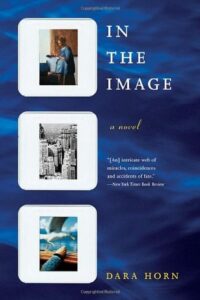By Dara Horn
 Reading IN THE IMAGE is like walking on a beach. If you focus on the details, you see shells and cabochons of surf-blasted glass. You smell the salty tang of the breeze ruffling your hair. You feel the sand scouring your feet.
Reading IN THE IMAGE is like walking on a beach. If you focus on the details, you see shells and cabochons of surf-blasted glass. You smell the salty tang of the breeze ruffling your hair. You feel the sand scouring your feet.
If you take the long view, you see the pulse of tides and blue-green water that touches every inch of shoreline on every continent. The vast connectedness of it humbles you.
Horn’s many-layered story ripples out from the lives of William Landsmann and Leora, his late granddaughter’s best friend. (The granddaughter, Naomi, was killed in a hit-and run accident in the New Jersey suburbs.) The book looks at Landsmann’s past – and Leora’s present.
Where this could have been just another tale of the Jewish immigrant experience, Horn takes it on one unexpected twist after another. For example, Landsmann’s grandmother, Leah, immigrates back to Eastern Europe when her young, new husband dies tragically in a New York fire.
Her son abandons his emotionally ill wife to a Nazi hospital and certain death. He survives the Holocaust as a free man living on the fringes of war-torn Vienna and Amsterdam where predators and prey struggle. By turns, he ignores and abuses his son, William.
After writing a river of letters to family in America, he is sponsored by a cousin. She, though not unsympathetic, expects him to do honest work in her business. The dullness wilts his spirit. At the local Jewish center, other survivors dismiss him because he was never in a camp. One day, he kills himself.
By contrast, Leora’s first boyfriend, Jason, a soccer jock, comes from such a secular Jewish family he cannot even identify a Chasidic Jewish family when he sees one. By the end of the book, he has become a Chasidic Jew, working in his father-in-law’s diamond business.
Leora meets her fiancé, Jake, at a Spinoza lecture in Amsterdam (another irony, given that Baruch Spinoza was expelled from Jewish society because of his controversial ideas about the nature of God). Their attraction and affection are touching and full of promise. Unknowingly, Jake buys the diamond for Leora’s engagement ring from Jason.
Early in the book, an old man with dementia – Mr. Rosenthal – repeatedly tells a young volunteer to become a deep-sea diver: “Deep sea divers, they go and get things back from the bottom of the ocean, don’t they?”
Mr. Rosenthal then describes how — as the ship that brought him to America entered New York harbor — people thronged out of steerage. Mr. Rosenthal thought they wanted to see the Statue of Liberty. When he got closer, he saw they were throwing their tefillin overboard “because tefillin were something from the Old World, and here in the New World they didn’t need them anymore.” (Tefillin are small leather boxes that Orthodox Jewish men wrap around their arms and heads before saying morning prayers.)
As her wedding approaches, Leora has a dream in which she dives into the waters around Manhattan. As she goes deeper, she sees wondrous things left behind by those who went before — things she desperately wants to save.
IN THE IMAGE ends with hope. Despite the troubles of the past, it’s clear that Jewish life is alive and vital. What many Jewish immigrants turned their backs on, their grandchildren and great-grandchildren are rediscovering and treasuring.
The Author: Dara Horn (1977 – )
Born and raised in New Jersey, Dara Horn was named by Granta magazine as one of the Best Young American Novelists in 2007, the year after she graduated from Harvard University with a doctorate in comparative literature.
IN THE IMAGE was her first novel and won the 2003 National Jewish Book Award, a 2002 Edward Lewis Wallant Award and the 2003 Reform Judaism Fiction Prize. Her second book, THE WORLD TO COME (about a stolen Chagall painting), received the 2006 National Jewish Book Award for Fiction, the 2007 Harold U. Ribalow Prize and was selected as an Editors’ Choice in The New York Times Book Review and as one of the Best Books of 2006 by the San Francisco Chronicle.
She also wrote A GUIDE FOR THE PERPLEXED, STRING THEORY: THE PARENTS ASHKENAZI (which is the prequel to A GUIDE FOR THE PERPLEXED), ALL OTHER NIGHTS, and THE RESCUER. With Norman Podhoretz, she co-wrote WHAT AMERICA OWES THE JEWS, WHAT JEWS OWE AMERICA.
She has taught Jewish literature and Israeli history at Harvard and at Sarah Lawrence College as well as lecturing at educational and cultural institutes throughout the United States and Canada. She, her husband and four children live in New Jersey.


